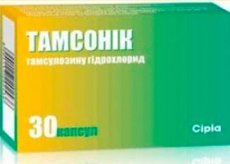Medical expert of the article
New publications
Preparations
Tamsonic
Last reviewed: 03.07.2025

All iLive content is medically reviewed or fact checked to ensure as much factual accuracy as possible.
We have strict sourcing guidelines and only link to reputable media sites, academic research institutions and, whenever possible, medically peer reviewed studies. Note that the numbers in parentheses ([1], [2], etc.) are clickable links to these studies.
If you feel that any of our content is inaccurate, out-of-date, or otherwise questionable, please select it and press Ctrl + Enter.

Tamsonic is an alpha-blocker used in the treatment of benign prostatic hyperplasia.
Indications Tamsonic
The drug is indicated for the symptomatic treatment of functional disorders in BPH.
Release form
Available in capsule form. 1 blister contains 10 capsules. One package contains 3 blister strips.
Pharmacodynamics
Selectively blocks postsynaptic adrenergic receptors (type α1A) in the smooth muscles of the prostate, prostatic region of the urethra, and in addition the neck of the urethra, and also reduces the muscle tone of these organs. The ability to interfere with the activity of adrenergic receptors of the α1A type is 20 times greater than a similar effect on adrenergic receptors of the α1B type in smooth vascular muscles. At the same time, no significant effect on systemic blood pressure is observed. In addition, the drug reduces the severity of irritation with obstruction in the urethra in BPH, and also improves the function of urine outflow. The effect of taking the drug appears after 2 weeks.
Pharmacokinetics
After oral administration, Tamsonic is almost completely absorbed in the gastrointestinal tract (more than 90% of the substance). When taken with food, bioavailability increases, as does the peak concentration in the blood plasma, while the time to reach this peak increases (when taken on an empty stomach, it occurs after 4-5 hours, and when taken with food - after 6-7 hours). The equilibrium concentration is reached by the 6th day of the course of use, and the peak values in this case will be 60-70% higher than Cmax after a single use.
It binds to plasma proteins (mainly α1-glycoproteins) by 94–99%, and the distribution volume is 0.2 l/kg of weight. Metabolism occurs in the liver with the participation of cytochrome type P450, quite slowly, in the process forming active decay products that retain high selectivity for α1-adrenoreceptors. In blood plasma it is in unchanged form.
The half-life is 9-13 hours in a healthy person, and 14-15 hours in a patient undergoing treatment. Most of the substance is excreted through the kidneys in the form of conjugates of decay products together with H2SO4 and glucuronic acid (while 10% remains unchanged), and the remaining small part is excreted in the feces.
Dosing and administration
It is necessary to use 1 time/day at 0.4 mg, 30 minutes after a meal. In cases where the medicine for some reason was not taken for 1 or several days, it is necessary to start taking it again with a dosage of 0.4 mg. The capsule must be swallowed with water, without crushing, chewing or opening.
Contraindications
The drug is contraindicated for use in the following cases: intolerance to the components of the drug, a history of postural hypotension, and in addition, renal or hepatic insufficiency. It should also not be used by children and women.
Side effects Tamsonic
Side effects after taking the medicine:
- Cardiovascular system: in very rare cases postural hypotension;
- Sensory organs and nervous system: rarely headache and dizziness, as well as asthenia, very rarely – insomnia or, conversely, a feeling of drowsiness;
- Urogenital system: rarely (8.4%) reverse ejaculation, extremely rarely – decreased libido;
- Others: in some cases, runny nose, back pain, diarrhea, very rarely – nausea or chest pain.
 [ 1 ]
[ 1 ]
Overdose
Symptoms of overdose include: a sharp decrease in blood pressure. In this case, the patient should lie down, after which vasoconstrictor drugs or plasma-substituting solutions are administered. To prevent absorption of the drug, the stomach should be washed, activated carbon should be taken, and then an osmotic laxative should be used. Since tamsulosin hydrochloride binds to plasma proteins by 94-99%, hemodialysis will be effective.
Interactions with other drugs
In case of combination with other α1A-type beta-blockers, an increase in hypotensive properties is possible.
When tamsulosin is combined with the substance cimetidine, the clearance rate of the former decreases by 26%, while AUC, on the contrary, increases by 44%.
In combination with furosemide, the concentration of the drug in the blood plasma decreases.
Concomitant administration with warfarin or diclofenac accelerates the process of eliminating tamsulosin from the body.
 [ 4 ]
[ 4 ]
Storage conditions
The medicine must be kept at a temperature of no more than 25°C.
Shelf life
Tamsonic is permitted to be used for 2 years from the date of manufacture of the medicine.
Attention!
To simplify the perception of information, this instruction for use of the drug "Tamsonic" translated and presented in a special form on the basis of the official instructions for medical use of the drug. Before use read the annotation that came directly to medicines.
Description provided for informational purposes and is not a guide to self-healing. The need for this drug, the purpose of the treatment regimen, methods and dose of the drug is determined solely by the attending physician. Self-medication is dangerous for your health.

